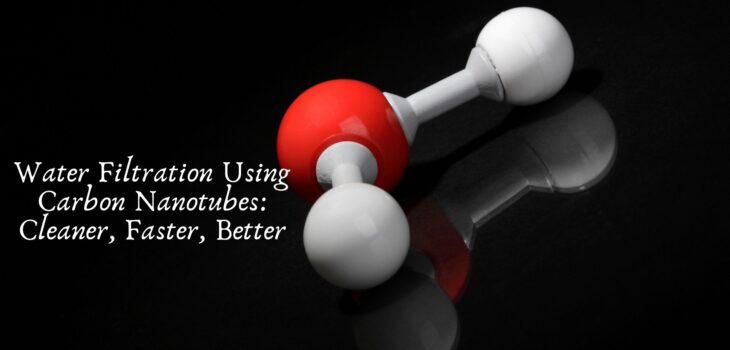 Business
Business
Water Filtration Using Carbon Nanotubes: Cleaner, Faster, Better
Access to clean water is one of the most critical global challenges of the 21st century. Traditional filtration technologies, while effective to a degree, often fall short in speed, efficiency, and the ability to remove contaminants at the nanoscale. In recent years, carbon nanotubes (CNTs) have emerged as a groundbreaking innovation in water filtration science. Their unique structure, high surface area, and exceptional adsorption capabilities make them a promising solution to produce cleaner water, faster and more efficiently than ever before.
What Are Carbon Nanotubes?
Carbon nanotubes are cylindrical nanostructures made from sheets of graphene rolled into tubes. These tubes can be single-walled (SWCNTs) or multi-walled (MWCNTs), with diameters ranging from 1 to 100 nanometers and lengths that can be several micrometers or more. Their structure provides remarkable mechanical strength, thermal conductivity, and chemical stability, making them ideal for advanced engineering applications—including water purification.
Why Carbon Nanotubes in Water Filtration?
Carbon nanotubes are particularly effective in water filtration due to several key properties:
- High surface area: This allows for extensive interaction with pollutants and contaminants.
- Hydrophobic and hydrophilic modifications: CNTs can be chemically tailored to either repel or attract water molecules, enhancing filtration flexibility.
- Antimicrobial properties: CNTs can disrupt bacterial membranes, making them useful in preventing biofouling.
- Nano-scale filtration: Their small pore sizes and high aspect ratios enable the removal of viruses, heavy metals, and organic compounds at the molecular level.
How CNT-Based Filters Work
CNTs can be integrated into membranes or filtration systems in several configurations:
- CNT Membranes: These are typically fabricated by aligning nanotubes vertically or embedding them in polymer matrices. Water molecules pass through the inner cores of the tubes, while contaminants are blocked or adsorbed.
- CNT Composites: CNTs are combined with other materials like polymers, ceramics, or activated carbon to enhance filtration capacity and mechanical strength.
- Functionalized CNTs: Chemical modification of CNT surfaces allows them to target specific contaminants such as arsenic, lead, or pharmaceutical residues.
Advantages Over Traditional Methods
Carbon nanotube-based filtration offers several benefits over conventional systems:
- Faster Flow Rates: Water can move quickly through CNT channels due to low friction, reducing processing time.
- Superior Filtration: CNTs can remove pollutants at a much smaller scale than conventional filters, including viruses and nanoparticles.
- Energy Efficiency: Due to their fast flow and high permeability, CNT membranes often require less energy compared to reverse osmosis or distillation.
- Durability: CNT filters are more resistant to wear, chemical corrosion, and microbial attacks, resulting in longer operational lifespans.
Applications in Real-World Scenarios
CNT-based filtration technology is being explored and implemented in various domains:
- Municipal Water Treatment: Incorporating CNTs into filtration plants can boost purification efficiency, especially in removing micro-pollutants.
- Point-of-Use Systems: Portable CNT filters are ideal for emergency relief operations, camping, or use in underdeveloped regions.
- Industrial Wastewater Treatment: CNTs can capture heavy metals and complex organic molecules from industrial effluents.
- Desalination: Research shows CNT membranes can help reduce the energy barrier for salt rejection, making desalination more feasible and less energy-intensive.
Environmental and Health Considerations
While CNTs hold immense promise, safety concerns remain. Free CNTs released into the environment could pose risks to ecosystems and human health. Researchers are developing safe fabrication techniques and immobilization strategies to ensure CNTs remain embedded within filters and are not released into water supplies.
Moreover, the production of CNTs still involves relatively high costs and energy input. However, advancements in scalable synthesis and green production methods are making them increasingly viable for commercial use.
Recent Advances and Future Outlook
The field of CNT-based water purification is rapidly evolving. Notable advancements include:
- Smart Filters: Integrating sensors with CNTs to monitor water quality in real time.
- Hybrid Membranes: Combining CNTs with graphene oxide or metal-organic frameworks (MOFs) for enhanced performance.
- Reusable Filters: Developing self-cleaning CNT membranes that can be reused multiple times without losing efficacy.
In the future, CNT water filters may become a common component in household purifiers, industrial treatment systems, and even in wearable hydration packs. With global water demand projected to rise by 55% by 2050, CNTs could play a pivotal role in securing clean and safe water for billions.
Conclusion
Water filtration using carbon nanotubes is not just a futuristic concept—it is a present-day innovation with transformative potential. Offering cleaner water, faster filtration rates, and superior efficiency, CNT-based technologies address many of the shortcomings of traditional systems. As safety, cost, and scalability continue to improve, carbon nanotubes are poised to become a cornerstone of global water purification strategies—ensuring a sustainable and healthier future for all.









